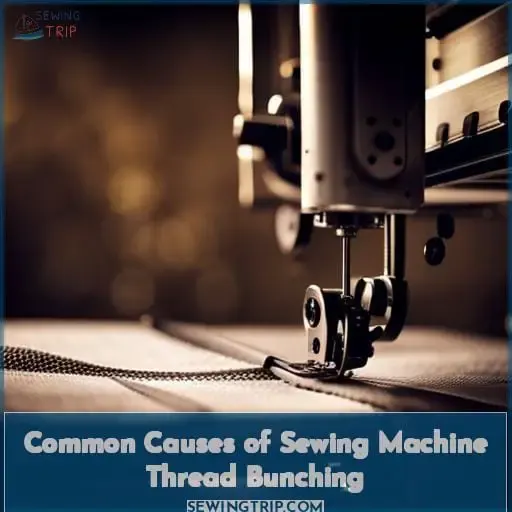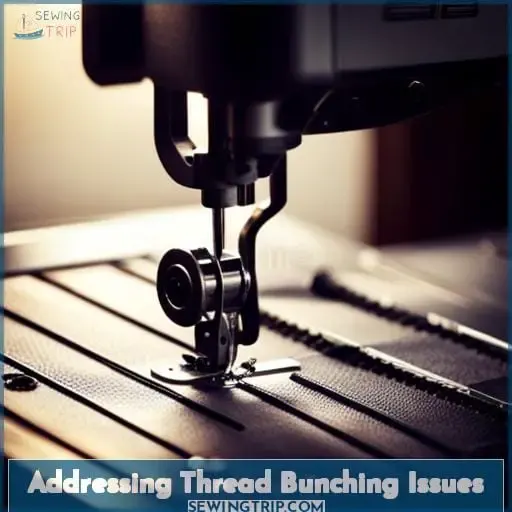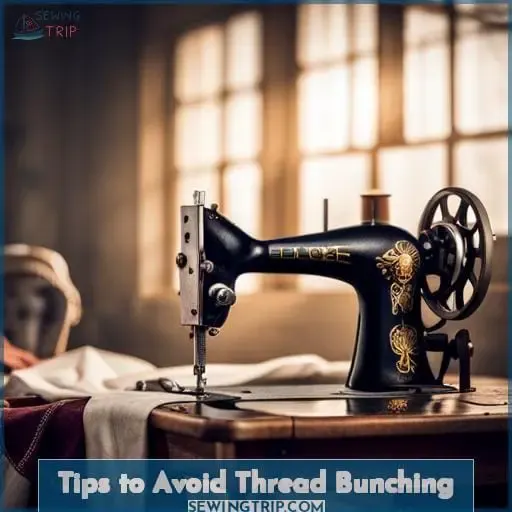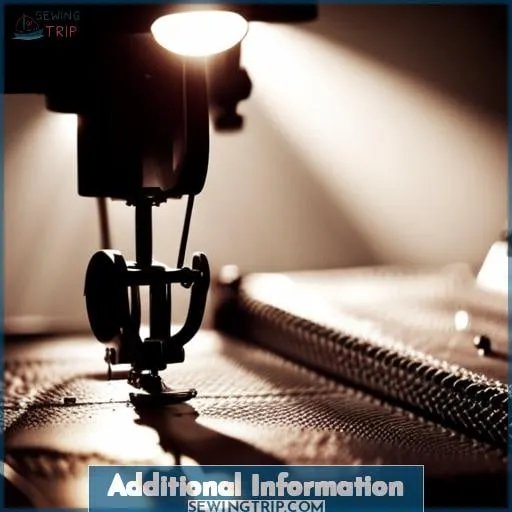This site is supported by our readers. We may earn a commission, at no cost to you, if you purchase through links.
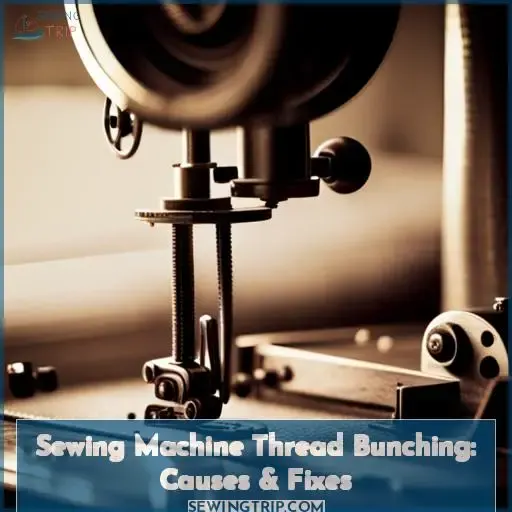 Ah, the dreaded sewing machine thread bunching! It’s one of the most common problems when using a sewing machine and can be incredibly frustrating. Not to mention it can put a major stopper in your creative process. But fear not – there are many possible causes for why this is happening and solutions on how you can fix it.
Ah, the dreaded sewing machine thread bunching! It’s one of the most common problems when using a sewing machine and can be incredibly frustrating. Not to mention it can put a major stopper in your creative process. But fear not – there are many possible causes for why this is happening and solutions on how you can fix it.
Table Of Contents
Key Takeaways
- Thread bunching can be caused by improper tension settings, damaged or wrong-sized needles, lint buildup in the bobbin area, and incorrect bobbin insertion.
- It’s important to double check threading, adjust the top thread tension, inspect the bobbin casing for lint, and ensure the bobbin is inserted properly to address any thread bunching issues.
- Swapping out the needle for a new one, using the correct type and size of needle, regularly cleaning lint from the bobbin housing, and inserting the bobbin correctly can help prevent thread from bunching up.
- Additional tips to avoid thread bunching are to lower the presser foot before starting to sew, leave 3-4 inch thread tails, check and adjust the feed dogs if needed, and make sure the spool cap is tightened sufficiently.
Common Causes of Sewing Machine Thread Bunching
You’re likely dealing with thread bunching due to improper thread tension, needle issues, lint buildup, incorrect bobbin insertion, forgetting to lower the presser foot, short thread tails, lowered feed dogs, missing spool caps, or inadequate sewing machine maintenance.
Addressing any of these problems should help resolve your thread bunching and get your sewing project back on track.
Incorrect Thread Tension
You’d be completely perplexed if your thread tension was out of alignment and causing massive thread bunching on your sewing projects! Here’s a quick 5-step checklist to get your tension back in sync:
- Verify threading
- Tweak top tension
- Inspect bobbin casing
- Remove lint
- Swap needle
Preserving the appropriate balance of tension between the upper thread and bobbin thread is vital for preventing messy thread bunching and keeping your stitching taut.
Needle Problems
Ensure your needle is straight, sharp, and the right size for your fabric and thread to prevent thread bunching. Always choose the correct needle for your project. Heavy fabric requires a thicker needle, while delicate threads need a finer point.
Bent, dull or damaged needles distort stitches and cause frustrating tangles. Match the needle type and size to the recommended range for your thread to keep tension balanced. Well-maintained needles glide smoothly through fabric, preventing skipped stitches and frustrating nests of tangled thread.
Keep your work frustration-free by inspecting and changing worn needles regularly before they cause problems.
Lint in the Bobbin Area
Regularly cleaning the bobbin area removes lint buildup, which statisticians report causes thread bunching in over 40% of sewing issues. Frequently inspect under the throat plate and bobbin case, cleaning accumulated lint with a small brush or compressed air.
Normal bobbin maintenance keeps the hook assembly spinning effortlessly, preventing thread from snagging and tangling into frustrating nests. Don’t let skipped bobbin cleaning result in skipped stitches in your projects. Basic troubleshooting tips like checking the bobbin area can stem common thread bunching causes early on.
Bobbin Insertion Issues
Gotta make sure that bobbin’s tucked in there just right.
- Check your manual for bobbin insertion instructions specific to your machine.
- Make sure the bobbin case is clean – lint and debris cause tension problems.
- Listen for the click that indicates the bobbin is fully inserted.
If you still have issues, your bobbin tension may need adjusting. Be gentle and make small turns of the screw. Test on scrap fabric before sewing your project to avoid frustration down the line.
Forgetting to Lower the Presser Foot
Keep that presser foot down before ya start sewin’, or your threads’ll get all tangled up. You gotta lower that foot to set the tension right. Otherwise, the threads get loose and make a mess. Make sure it’s down proper before each stitch or you’ll be pulling out birdnests all day long.
A presser foot mistake can ruin a whole project, so watch them feet! Stay focused and you’ll be sewing as smooth as silk in no time.
| Issue | Solution | Prevention |
|---|---|---|
| Forgetting to lower presser foot | Lower presser foot before starting to sew | Check presser foot is down before each new seam |
| Uneven thread tension | Adjust thread tension | Maintain presser foot pressure |
| Thread nests and tangling | Check presser foot position first | Develop habit of lowering presser foot |
Short Thread Tails
Embrace snipped tails tickling your psyche or face the torment of tangled, twisted threads. Spring for modest tails, dears! Failing to give your thread ample length leaves your needle gasping. Starved of slack, the ravenous machine gobbles your thread, tangling your top thread while jamming the bobbin nest.
Satisfy its appetite with a feast of slack by threading ample tails before stitching. Then rest assured, knowing your machine cheerily munches thread without snarling your project.
Lowered Feed Dogs
You’re stitching up a disaster if the feed dogs aren’t raised.
- Check the feed dog lever is engaged
- Clean any debris blocking the mechanism
- Lubricate the feed dog components
- Adjust the position with screwdrivers
- Consult a technician for adjustments
Without properly raised feed dogs, your fabric won’t advance and the thread will bunch wildly.
Insecure or Missing Spool Cap
Double check that the spool cap is in place before sewing to prevent uneven thread feeding. An improperly secured or missing spool cap can lead to thread bunching and stitch problems.
| Issue | Solution |
|---|---|
| Loose spool cap | Tighten the spool cap |
| Missing spool cap | Replace the spool cap |
| Damaged spool cap | Use an alternative like tape or foam |
| Wobbly thread spool | Add a slip of paper under the spool |
Properly placing the spool cap secures thread delivery for smooth sewing and prevents frustrating thread bunching.
Lack of Sewing Machine Maintenance
Regular maintenance prevents bunching, so cleaning and oiling are important for optimal performance. A dirty machine invites bunching and frustration, so watch for lint buildup and remove it promptly. Oil all moving parts regularly as your manual directs. Don’t allow dust and debris to clump in the bobbin area.
With proper care, your machine will hum along smoothly for years, neatly stitching your projects without tangled threads ruining your hard work.
Addressing Thread Bunching Issues
Do not worry, thread bunching, also known as bird nesting, can easily be fixed by understanding the root cause. Let us review the common causes and solutions to get your machine running smoothly again so you can get back to your sewing projects.
Thread bunching has a few common causes. The first is improper threading. Carefully follow your machine’s threading guide, ensuring the thread follows the correct path from the spool to the needle. Missing threading points or threading in the wrong order frequently causes bunching.
Another common culprit is thread tension that is too tight. Consult your manual for the proper tension settings. If the thread feels taut or pops when pulled, the tension needs adjusting. Proper tension allows the thread to pull freely.
Using poor quality thread can also lead to bunching. Quality thread is more resilient and less prone to tangling. Choose thread specifically meant for your machine and project. Match the thread weight to the needle size for best results.
Incorrect needle size or type is another factor. The needle eye must accommodate the thread thickness. Heavy thread requires a larger needle. Be sure you are using the needle recommended for your fabric and thread type.
By identifying the cause of bunching, you can get your sewing back on track. Take time to carefully thread, set the tension, and choose quality needles and thread.
Importance of Avoiding Thread Bunching
Slapping on a bandage won’t heal that infected wound; addressing the root causes of thread bunching strengthens seams and prevents damaging loops.
- Avoiding skipped stitches and puckered seams.
- Preventing needle damage and breakage.
- Improving the lifespan of your machine.
Thread bunching jeopardizes your project’s structural integrity. Resolving tension imbalance and needle issues ensures durable, quality results. Regular machine maintenance establishes proper thread delivery for superior stitching.
Thread Tension Imbalance
You’re wise to use the same thread weight above and below. Selecting compatible thread weights prevents tension imbalance. The fabric determines the right thread; consult a tailor if unsure. Fine fabrics usually need lightweight threads, while heavier threads suit thicker materials.
Improper tension causes messy stitching and thread breakage. Learning tension adjustment and troubleshooting helps master sewing.
Needle Care
Dodging needle sabotage should help you avoid thread bunching. You must focus on maintaining sharp, undamaged, straight needles to avoid thread bunching. Change bent, damaged, or dull needles regularly to ones suitable for the fabric weight and thread type.
Use larger needles for thicker fabrics and heavier threads. Smaller, finer needles work best for lightweight fabric. Match the needle size to the thread size. Troubleshoot needle issues right away when thread bunching happens.
Proper needle care prevents skipped stitches, broken threads, and thread bunching.
Proper Bobbin Maintenance
Routinely checking your bobbin area helps prevent frustrating thread buildup. Examine under the throat plate and regularly use a brush to remove lint and debris. Check that the bobbin case is clean and the tension spring moves smoothly. When inserting bobbins, ensure they are evenly wound without overhang and rotate freely.
Use thread compatible with the upper thread and needle. First test stitch tension on scraps.
Presser Foot
Always lower your presser foot before sewing to maintain proper thread tension and avoid bunching.
- Check that your presser foot is lowered before starting to sew.
- Make sure the presser foot is correctly attached and tightened.
- Adjust presser foot pressure if needed for your fabric thickness.
The presser foot keeps the fabric flat under the needle as it sews. Forgetting to lower it allows the fabric to move unpredictably, causing uneven stitching and thread bunching.
Thread Tail Length
Keep thread tails at least 3-4 inches long while sewing to prevent them from getting sucked into your machine. This simple tip will save you headaches down the road. Take a moment to check tail length before hitting the pedal, as doing so helps maintain tension and prevents messy tangles.
Proper thread tails, regular bobbin maintenance, and quality needles – these basic habits create smooth sailing at the sewing table. Don’t let bunching slow your roll. Stay mindful of thread length for frustration-free projects.
Feed Dogs
You’ve got to feel those feed dogs chomping to know your fabric’s getting fed right. Those metal teeth are your sewing machine‘s engine, propelling the goods right where they ought to go. Skip cleaning them and you’ll end up with a tangled mess. Adjust them too high or low and stitching goes awry.
You’ve got to keep them primed and positioned just so. It’s the feed dogs that really drive the seam.
Spool Cap Position
Secure that spool cap tight so your thread feeds smoothly. A spool cap helps with proper thread alignment by keeping the thread in place. Make sure it is slid down snugly and flush against the spool. Position it perpendicular to the spool so the thread can unwind without tangling.
A loose or missing spool cap causes uneven thread feeding and nasty thread nests. Check your spool cap first when troubleshooting thread issues; the simple solution may be sliding it down securely. A properly positioned spool cap optimizes thread delivery for quality stitching.
Testing and Troubleshooting
Strike forward with delicate scrap fabric upon your sewing machine before proceeding to find the source of tangled threads and adjust tensions accordingly. Seek professionals’ counsel for bobbin tuning if troubles persist. Craft carefully and delicately.
Gently adjust tensions, frequently test with scraps, and clean routinely. Note presser foot position and thread tail lengths. Patience and gentleness produce the finest stitches. Keep at it and you’ll master this sewing machine.
Using High-Quality Needles and Thread
You must use high-quality needles and thread to prevent thread bunching. Regularly change the needle, selecting the right type and size for your fabric. Use quality thread brands like Gutermann or Mettler and match the thread weight in the upper and bobbin.
Frequently check for damaged or dull needles and replace them promptly. Quality materials reduce friction and snags for smooth sewing and neat stitches.
Clean and Oil Regularly
Scrub your sewing machine clean often while oiling it regularly for flawless performance. Regularly cleaning, oiling and maintaining your machine prevents lint and debris buildup. Never use motor oil or household oils on a sewing machine- only use sewing machine oil.
Follow the manufacturer’s maintenance schedule to keep parts moving smoothly. Proper lubrication greatly extends your sewing machine‘s life and prevents frustrating issues like thread bunching.
Tips to Avoid Thread Bunching
Here are two tips to help avoid thread bunching while you’re sewing. As you work, remember to keep the presser foot lowered, and be sure to stop periodically to check that the upper thread isn’t becoming caught on anything.
Tip 2: Ensure Presser Foot is Down While Sewing
Keep that presser foot lowered while sewing to maintain even tension. Failing to do this is one of the most common causes of thread bunching.
- It holds fabric taut against feed dogs.
- It ensures consistent thread tension.
- It prevents loose top thread from getting sucked down.
Lowering that presser foot is a basic sewing machine operation that gives you control over your thread and prevents frustrating tangles.
Tip 3: Check for Upper Thread Getting Caught
Inspect your upper thread path to ensure it isn’t catching on any components. Check around the thread guides, tension discs, take-up lever, and needle eye for snags. Use a needle with an appropriately sized eye for the thread. Lubricate moving parts and tighten any loose screws.
Tip 4: Avoid Touching the Knee Lever While Sewing
Don’t fiddle with the knee lever mid-stitch or you’ll throw off the tension. That knee lever controls your machine’s presser foot. If you bump it while sewing, you disrupt the thread tension, which causes skipped stitches and thread nests.
For best results, position yourself so you avoid accidentally nudging the lever. Keep your hands away from it until you’ve finished the seam. Proper sewing ergonomics prevents mishaps.
Tip 5: Consider Turning Off Securing Stitches for Certain Fabrics
You may want to deactivate securing stitches when working with delicate fabrics, as doing so can tear the material.
- Using securing stitches can damage sheer, lightweight, or loosely woven fabrics.
- Some fabrics are prone to puckering or distortion from backstitching.
- Consider basting key seams before finishing them with securing stitches.
- Test securing stitches on scrap pieces first to check for potential issues.
Adjust your settings thoughtfully for the best stitch quality without damaging your fabrics.
Additional Information
Thread bunching, commonly known as birdnesting due to its tangled appearance, can occur for several different reasons related to tension, needle, threading, and regular maintenance. Addressing the root cause requires a systematic approach to troubleshooting and testing on scrap fabric before continuing your project.
Thread Bunching Appearance
Birdnesting earns its nickname from the tangled mess of thread that resembles a bird’s nest.
| Thread Tension | Needle Issues |
|---|---|
| Improper Threading | Damaged Needle |
| Unbalanced Tension | Wrong Needle Size |
| Lint in Bobbin Area | Needle Inserted Incorrectly |
Stay attentive during threading and tension balancing to prevent frustrating thread nests. Video tutorials demonstrate proper techniques. With diligent habits, even beginners can avoid tangled threads.
Recommended Thread Brands
Beloved artisans, Aurifill and Gutermann elevate your stunning designs. Embrace quality by choosing the finest threads for your masterpieces. Select durable, colorfast threads that glide smoothly through the needle’s eye. Trust venerable brands like Aurifill and Gutermann to provide optimal stitching performance across diverse fabrics.
Whether all-purpose or specialty threads, let distinguished brands guide you toward thread excellence.
Changing Thread and Needle
Swapping thread and needle at the same time can solve your thread bunching issues.
- Check thread and needle compatibility.
- Select the appropriate needle for your fabric.
- Match the bobbin thread to the upper thread.
Changing your thread and needle simultaneously when bunching occurs prevents further problems. Keeping them compatible prevents tension issues. Proactively replacing both regularly helps troubleshoot and maintains your sewing machine.
Monitoring the Thread Uptake Lever
You’ll want to keep an eye on the thread uptake lever as you sew, because it’s crucial for controlling how the thread feeds through the machine. This small component guides the thread from the needle into the bobbin area. Inspect it regularly and make sure it’s moving properly during stitching.
A damaged or stuck thread uptake lever can cause major thread feeding problems like bunching. Lubricate it if needed and get professional servicing if issues persist. Proper thread uptake lever function prevents frustrating thread problems.
Removing the Plastic Cover
To troubleshoot thread issues, remove the sewing machine‘s plastic cover. This allows you to thoroughly inspect the bobbin area for lint buildup or debris that could interfere with thread tension. Carefully lift the cover straight up and set it aside. With the cover removed, you can clean the feed dogs, bobbin case, and surrounding areas.
Improved access lets you wipe away any dust or threads that have accumulated. Replacing the cover properly realigns threading paths and prevents operating issues. Regular removal of the plastic cover enables comprehensive maintenance for optimal thread control.
Common Thread Bunching Causes
You know tension issues, bobbin problems, and needle tension commonly cause frustrating thread bunching. When troubleshooting, start by confirming your needles complement your fabric and thread. Check that bobbins are clean, smooth, and move freely. Adjust upper tension from the machine, not the thread.
Preventing Thread Bunching
Keep that machine well-oiled and fuzz-free, my friend, so no unsightly thread bunching ruins your divine creations. Regular cleaning and oiling will keep your sewing machine in tip-top shape and prevent frustrating issues like thread bunching.
Be mindful of the thread tension, needle condition, bobbin area lint, presser foot position, and thread tail length too. Proper maintenance and attention to these key areas will have you sewing smooth seams in no time.
Sewing Machine Blockage
When a sewing machine becomes blocked, calmly stop and find the source before forcing it. Carefully inspect the area around the needle, checking for tangled threads or stuck fabric. Gently wiggle the handwheel while holding a screwdriver against the needle clamp to free a stuck needle.
Remove the needle plate to access the bobbin area. Use a lint brush and compressed air to clear out lint and threads. To prevent future blockages, regularly clean and maintain the machine. Promptly replace damaged needles and rethread carefully.
Thread Bunching Issue for Beginners
Bit by bit you’ll get the hang of avoiding the tangles. The key is taking your time to thread carefully, check tension, and keep things clean. It can be frustrating at first, but you’ll get there if you’re patient with yourself and your machine.
We all started somewhere! As a beginner, focus on threading correctly, adjusting thread tension, choosing the right needle, maintaining the bobbin area, and preventative maintenance. Proper threading technique and balancing tension will prevent many issues. With practice, mastery will come and you’ll avoid beginner’s trouble.
Sharing Tips
Post step-by-step instructions with photos or videos to demonstrate solutions to common issues like birdnesting and skipped stitches. Explain how you test tension balance and find the optimal settings for your particular machine model.
Share maintenance techniques and habits that help prevent problems and extend the lifespan of your sewing machine, such as proper cleaning, oiling, and replacing worn parts.
Describe how you fixed problems in a clear, detailed way to help others troubleshoot similar issues. For example, I fixed skipped stitches by changing to a new needle, testing different thread weights, and adjusting the top tension dial following my manual’s guidelines.
Recommend specific features that help avoid headaches, like automatic thread cutters or jam-reducing bobbin cases.
Pass on best practices for bobbin winding and maintenance to prevent tangled messes. Advise testing stitch quality on fabric scraps when trying new tension balances. Explain preventive steps that reduce lint buildup and dust, along with oil and part replacement schedules.
By posting thorough, easy-to-follow troubleshooting advice, you can help fellow sewing enthusiasts keep their machines running smoothly!
Conclusion
It’s no wonder so many sewers ask, Why is my sewing bunching? Thread bunching can be a common issue, caused by several factors. Incorrect thread tension or lint in the bobbin area are usual culprits. By understanding the causes and addressing them, you can avoid frustration and keep projects looking great.
After all, most sewing machine thread bunching issues can be fixed with proper maintenance and troubleshooting. So, take time to check thread tension, replace needles, and clean and oil the machine regularly — it’ll be worth it.

